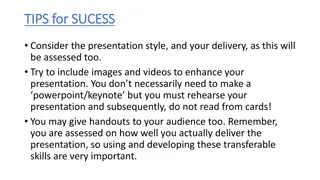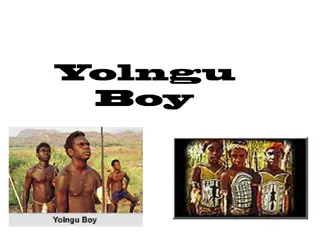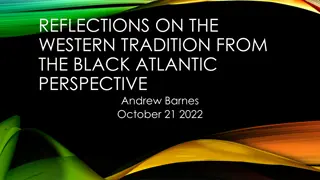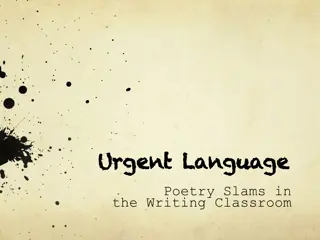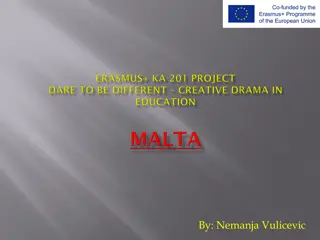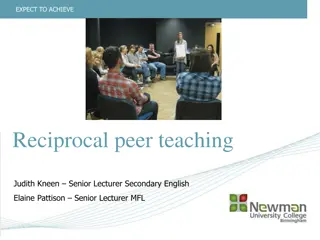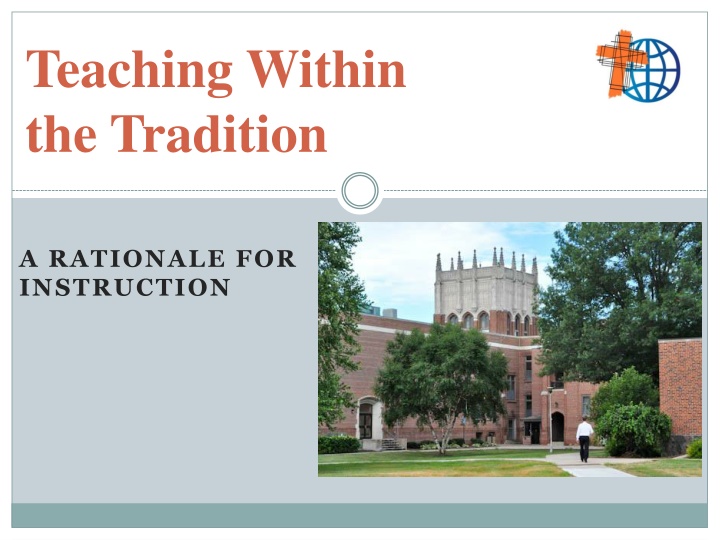
Rationale for Instruction: Models for Faith Integration and Education
Explore three models for integrating Biblical and theological themes in teaching practices within the Christian tradition, including devotional, worldview, and synthetic integration approaches. Discover the intersection approach for a distinctly Lutheran perspective on faith and education.
Uploaded on | 0 Views
Download Presentation

Please find below an Image/Link to download the presentation.
The content on the website is provided AS IS for your information and personal use only. It may not be sold, licensed, or shared on other websites without obtaining consent from the author. If you encounter any issues during the download, it is possible that the publisher has removed the file from their server.
You are allowed to download the files provided on this website for personal or commercial use, subject to the condition that they are used lawfully. All files are the property of their respective owners.
The content on the website is provided AS IS for your information and personal use only. It may not be sold, licensed, or shared on other websites without obtaining consent from the author.
E N D
Presentation Transcript
Teaching Within the Tradition A RATIONALE FOR INSTRUCTION
Instruction Models for Faith and Higher Education Christian teachers typically talk about including Biblical and theological themes in course content as faith integration. This expression has had a strong and respected use in the Calvinist tradition (Cf. Abraham Kuyper). And Lutheran education to some extent has imported it. The series that follows presents three models for bringing together our teaching and theological content. The third model features a distinctly Lutheran intersection approach rather than integration. These three models yield four modes of practice for instruction. Again, what do those of us in the offices think we re doing in the classrooms?
Model 1: The Funnel Devotional integration focuses on prayer, devotions, and Biblical course themes to open doors and create opportunities for witness. World view integration highlights various world views including Christian to compare and contrast as lenses of life and meaning. Ethical integration challenges students to contrast various moral rationalities and choices as a way to distinguish the Christian life. As the funnel image suggests, these three kinds of integration may or may not be combined. Devotional Integration Worldview Integration Vocational & Ethical Integration Faith and Learning in the University Classroom (Bernard Bull, 2012, Concordia University Wisconsin Repository)
Model 2: Migliazzos Levels of Integration SYNTHETIC INTEGRATION VALUES INTEGRATION MULTIDIMENSIONAL INTEGRATION ROLE MODEL INTEGRATION
Model 2, cont: Migliazzos Levels of Integration 1. Role Model Integration focuses on discipline content and teaching excellence attention-getting student-initiated inquiry about faith personal testimony 3. Values Integration actively examines and critiques underlying world view assumptions moves to the ethical, moral, philosophical, and spiritual presuppositions students become actively involved in the exploration uses supplementary readings, summary sheets, small group work, student disputation stops short of applying distinct biblical themes 4. Synthetic Integration compares the discipline s paradigm with historical Christian thinkers and themes examines the discipline s epistemology and sources of authority presents a coherent spiritual tradition and ethos for scrutiny and challenge 2. Multi-Dimensional Integration identifies world views compares/contrasts ideologies includes some biblical frame of ref for reality (Migliazzo, 2002, p. 317)
Model 3: A Two Kingdoms Intersection Approach God s Right-Hand Kingdom of Grace God s Left-Hand Kingdom of Creation Intersections are selected opportunities where course content intersects with Reformation and other Biblical themes speech acts serve as efficacious promises, words of hope, indicators of grace, etc. intersect with student receptiveness, drawing the student toward the right-hand kingdom. community events, practices, and incidents in harmony or tension with God s word of Law or of Gospel can function as spiritually loaded incidents. a decision or action (individual or community) publicly alerts us to the distinction and tension between the two kingdoms sometimes costly. (Moulds, 2014, http://wp.cune.edu/twokingdoms)
Model 3, cont: A Two Kingdoms Intersection Approach God s Right-Hand Kingdom of Grace God s Left-Hand Kingdom of Creation Some discussion, keeping in mind that this is not a mandate or system : God s right hand intersecting, permeating, penetrating, infusing, infecting, invading, intruding on the left-hand. The conventional (our proper or usual mode) disrupted by the peculiar. Most of the time, we operate conventionally. But Opportunistic: seizes or sets up instances where students and community can re-assess their motivation, direction, and relationship with God and with the world using Biblical themes and the Reformation insights with an emphasis on the Gospel. Apart from the Gospel, all our other sources direct us only to the form of this present world (cf 1 Cor 7:29-31). No domain public, private, scientific, cultural, commercial, personal, communal is exempt from the reach of God s right hand.
So what do you think? Table Talk: assess and critique these three methods and their variations. Do any of these work ? Where might the various Reformation insights about the Gospel fit in? Does one model or approach fit your discipline or area of service better than the others? Is the proposed difference between intersect and integrate valid? _________________
Models Summary: 4 Modes Relational: uses personal interest, interpersonal style, role model, personal testimony, and perhaps accepted devotional practices of opening prayer and biblical course themes. World Views: Spells out alt versions and grand narratives of reality Jihadist, scientism, post- modern, Lutheran, Marxist, aggressive secularism, etc. Whose justice? Which rationality? Why? Ethical / Values Issues: Intersections: selects and creates course content that intersects with Biblical themes (covenant, grace, justice, etc.) and our tradition (incarnational theology, simul, vocation, 2K, etc.) Uses course topics, local issues, community incidents, news, etc. to explain this tradition for comprehension.Ex: See content examples in this web site. examines ethics and values claims using issues in the subject area or news. Exposes the underlying assump- tions for comp/ contr. May or may not apply a Biblical perspective. Ex: Math prof consoling his student about miscarriage Ex: same-sex marriage Ex: radical Islam Course content salted with issues and examples. Course content may include a Biblical framework for ref. Course content remains focused on conventional subject area.
Christ and Curriculum: 4 Approaches Personalizing: Intersections: Allegorizing: Integration: Uses lationships, interpersonal style, role model, personal testi- mony, and appropriate devotional practices of opening prayer and biblical course themes. Koinonia and community create opportun- ities for witness. Course content remains focused on conventional subject area. Selects and creates course content that intersects with Biblical themes (grace, justice, covenant etc.) and our tradition (incarnational theology, simul, vocation, 2K, etc.) Discipline content remains conven- tional; standard Biblical themes inform content, critique, applica- tion, etc. See the 2K web site for examples. All truth is God s truth thus, all truth that we teach corresponds at some level to God s word. Energy levels in physics are analogous to spiritual domin- ions; empires rising and falling are allegories of creation and the fall. Course con- tent provides similes and metaphorical comparisons. Selects discipline content that matches Biblical truths, themes, and content: beauty and symmetry in math integrates with order and structure of creation; social patterns of error, penalty, and progress integrates with the Bible s sin, judgment, and grace. Course content and Bible are integrated.
A Two Kingdoms Venn Diagram God s right-hand kingdom of grace marked by word and sacrament in a now but not yet reality along side the present post- Genesis 3 creation. God s left-hand kingdom of creation and temporal institutions, e.g., family, the church, civil government, commerce, etc. The life of the Christian as a citizen of both kingdoms (cf Rom 13:1ff and Phil 3:20) where we live out our call (L., voco, to call) from Christ to faith and to live out that faith (vocation) in family relationships, congregation, occupation, etc. A Venn is helpful but limited: tends toward being 1) static 2) personal only. Let s try another approach
An Intersecting Parallels Diagram God s Right-Hand Kingdom of Grace God s Left-Hand Kingdom of Creation Rather than a Venn diagram which implies the kingdoms are static, this Arrow Diagram with multiple intersections indicates that the kingdoms and their intersections are dynamic strategies. This dynamic preserves us from errors such as trying to integrate the kingdoms, seeking to compartmentalize the kingdoms with simplistic right-and-wrong solutions, living under the law ( let s just make a new rule ), or worshiping at the altar of perfection rather than returning again and again to the cross of Christ.
A Flexible Intersections Approach Course content Or re-sequence and edit these as may be best. The pieces can be omitted, included, adjusted, and adapted as the instructor prefers. It s not a formula or recipe. Formation: 2 Cor 3:18, etc. Event, issue, or example Insight from tradition Biblical content
A Closing Perspective Most small colleges will in the years to come try to ally themselves with the normative secularism of the research university by mimicking them (at which they will fail for lack of resources) or by seeking to become feeder schools to their graduate programs (at which some will succeed if they have the resources to prepare their students). However, the now-normative secularism is flat that is, it accumulates data and new information but has no authentic or compelling way to interpret or draw meaning from its own research. The Christian college has the opportunity to include a depth dimension that the research university cannot provide. That is, the Christian college can connect content to sources, roots, and traditions and, so, provide meaning that normative secularism by its own definition cannot do. Many parents and students (not all) will value this capacity of the Christian university. In any event, the Christian college or university has a vocation to be about this work. (See also work by Reinhard Hutter, Duke University, and Robert Benne , Roanoke College.)
Alt -- A Closing Perspective Most small colleges will, in the years to come, try to ally themselves with the normative secularism that now characterizes the state- or industry-funded research university either by 1) mimicking them, at which they will fail for lack of resources; or 2) by propagating graduate programs scaled back in scope and targeted at narrow occupational goals, from which most of these small schools will attrition in a bidding war for enrollment. Concordia, however, recognizes this now-normative secularism in modern and postmodern higher education is flat that is, it accumulates data and new information but has no authentic or compelling way to interpret or draw meaning from its own research. The Christian university provides the depth dimension that the research university cannot provide. That is, Christian higher education connects content to sources, roots, and deep traditions and, so, provides meaning that today s acculturated secularism, by its own definition, cannot do. Students who regard graduate study as more than merely an occupational certificate will value this capacity of the Christian university. And the Christian university that values its identity has a vocation to be about this work. (See also work by Reinhard Hutter, Duke University, and Robert Benne , Roanoke College.)




